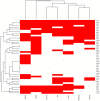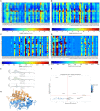The Mutational Landscape of the Oncogenic MZF1 SCAN Domain in Cancer
- PMID: 28018905
- PMCID: PMC5156680
- DOI: 10.3389/fmolb.2016.00078
The Mutational Landscape of the Oncogenic MZF1 SCAN Domain in Cancer
Abstract
SCAN domains in zinc-finger transcription factors are crucial mediators of protein-protein interactions. Up to 240 SCAN-domain encoding genes have been identified throughout the human genome. These include cancer-related genes, such as the myeloid zinc finger 1 (MZF1), an oncogenic transcription factor involved in the progression of many solid cancers. The mechanisms by which SCAN homo- and heterodimers assemble and how they alter the transcriptional activity of zinc-finger transcription factors in cancer and other diseases remain to be investigated. Here, we provide the first description of the conformational ensemble of the MZF1 SCAN domain cross-validated against NMR experimental data, which are probes of structure and dynamics on different timescales. We investigated the protein-protein interaction network of MZF1 and how it is perturbed in different cancer types by the analyses of high-throughput proteomics and RNASeq data. Collectively, we integrated many computational approaches, ranging from simple empirical energy functions to all-atom microsecond molecular dynamics simulations and network analyses to unravel the effects of cancer-related substitutions in relation to MZF1 structure and interactions.
Keywords: FoldX; RNAseq; TCGA; cancer mutations; molecular dynamics; protein structure network; saturation mutagenesis; transcription factors.
Figures










Similar articles
-
Heterodimer formation of the myeloid zinc finger 1 SCAN domain and association with promyelocytic leukemia nuclear bodies.Leuk Res. 2008 Oct;32(10):1582-92. doi: 10.1016/j.leukres.2008.03.024. Epub 2008 May 9. Leuk Res. 2008. PMID: 18472161
-
Myeloid Zinc Finger 1 (MZF1) Maintains the Mesenchymal Phenotype by Down-regulating IGF1R/p38 MAPK/ERα Signaling Pathway in High-level MZF1-expressing TNBC cells.Anticancer Res. 2019 Aug;39(8):4149-4164. doi: 10.21873/anticanres.13574. Anticancer Res. 2019. PMID: 31366500
-
Characterization of the DNA-binding properties of the myeloid zinc finger protein MZF1: two independent DNA-binding domains recognize two DNA consensus sequences with a common G-rich core.Mol Cell Biol. 1994 Mar;14(3):1786-95. doi: 10.1128/mcb.14.3.1786-1795.1994. Mol Cell Biol. 1994. PMID: 8114711 Free PMC article.
-
Zinc Finger Transcription Factor MZF1-A Specific Regulator of Cancer Invasion.Cells. 2020 Jan 16;9(1):223. doi: 10.3390/cells9010223. Cells. 2020. PMID: 31963147 Free PMC article. Review.
-
Role and Regulation of Myeloid Zinc Finger Protein 1 in Cancer.J Cell Biochem. 2015 Oct;116(10):2146-54. doi: 10.1002/jcb.25203. J Cell Biochem. 2015. PMID: 25903835 Free PMC article. Review.
Cited by
-
Alterations of the interactome of Bcl-2 proteins in breast cancer at the transcriptional, mutational and structural level.PLoS Comput Biol. 2019 Dec 11;15(12):e1007485. doi: 10.1371/journal.pcbi.1007485. eCollection 2019 Dec. PLoS Comput Biol. 2019. PMID: 31825969 Free PMC article.
-
RosettaDDGPrediction for high-throughput mutational scans: From stability to binding.Protein Sci. 2023 Jan;32(1):e4527. doi: 10.1002/pro.4527. Protein Sci. 2023. PMID: 36461907 Free PMC article.
-
Systems Biology Approaches to Investigate Genetic and Epigenetic Molecular Progression Mechanisms for Identifying Gene Expression Signatures in Papillary Thyroid Cancer.Int J Mol Sci. 2019 May 23;20(10):2536. doi: 10.3390/ijms20102536. Int J Mol Sci. 2019. PMID: 31126066 Free PMC article.
-
An optimal distance cutoff for contact-based Protein Structure Networks using side-chain centers of mass.Sci Rep. 2017 Jun 6;7(1):2838. doi: 10.1038/s41598-017-01498-6. Sci Rep. 2017. PMID: 28588190 Free PMC article.
-
The Cancermuts software package for the prioritization of missense cancer variants: a case study of AMBRA1 in melanoma.Cell Death Dis. 2022 Oct 15;13(10):872. doi: 10.1038/s41419-022-05318-2. Cell Death Dis. 2022. PMID: 36243772 Free PMC article.
References
Grants and funding
LinkOut - more resources
Full Text Sources
Other Literature Sources
Molecular Biology Databases

